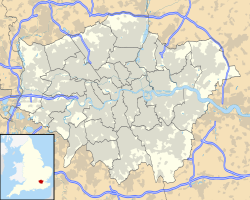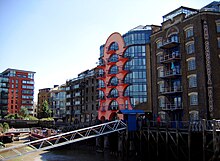Shad Thames
Location of the Shad Thames in Greater London |
The Shad Thames is an historic coastal road near the Tower Bridge in Bermondsey , a district of London . Unofficially, this also means the area around this street. The name is a sliver of the designation "St-John-at-Thames", a tribute to the former St John's Church at this location.
Location
Shad Thames Street begins to the west at Tower Bridge and runs along the south bank of the Thames where it is hidden behind a row of warehouses. Then it bends at a right angle to the south and runs along St Savior's Dock . It is partially paved. The closest underground stations are Tower Hill and London Bridge .
geography
The street Shad Thames is first named in John Rocque's London map from 1747. The area around this street is still called Shad Thames or Butler's Wharf (after the largest warehouse on the bank). Both names refer to 350 mx 250 m area that is built up with warehouses and newer buildings and borders the Thames, Tower Bridge Road , Tooley Street and St Savior's Dock (or Mill Street ). This is the northeast corner of the area with zip code SE1.
A version of the London map of London by Ralph Agas from the 1560s, published in 1633, names the area Horssey Down . In a city map from 1889 it is called Horsely Down , although it extends a little further to the south and west than today's Shad Thames. Even today, there is a street called Horselydown Lane near Tower Bridge , at one end of which is the Horseleydown Brewery (now an apartment block called Anchor Brewhouse ). Legend has it that Horseley Down is a looping of Whores lie down, but since the site was originally a large meadow for horses and cows grazing, it is more likely that it was looping off "Horse Down" (German: horse depression) is.
In the Victorian era , Shad Thames owned the largest warehouse complex in London. The warehouses were completed in 1873 and housed large quantities of tea, coffee, spices and other dry goods that were loaded onto or unloaded from river boats. In a book from 1878 it says:
“Shad Thames and actually the entire bank of the Thames is built on with huge granaries and warehouses to supply the metropolis. Indeed, the area from Morgan's Lane - a bend about the middle of Tooley Street on the north side to St Savior's (originally: Savory) Dock covers the whole street - called Pickle Herring Street on one side and Shad Thames on the other - along an uninterrupted row of berths, warehouses, mills and factories on either side of the narrow and busy pavement. "
During the 20th century, the area saw a decline as the increase in shipping traffic forced ships to load and unload further east, and the last of the warehouses closed in 1972. In the 1980s and 1990s, however, Shad Thames was revitalized when obsolete but picturesque warehouses across the area were converted into expensive condominiums, many with restaurants, bars and shops on the ground floor. The designer and restaurant owner Terence Conran made a name for himself , who owned a number of well-known riverside restaurants, such as B. the Pont de la Tour , the Blueprint Cafe and the Butler's Wharf Chop House opened. Many other restaurants, cafes, bars, and retail stores also appeared. The character of Shad Thames as a bohemian district has attracted many other businesses, such as B. Architects, small art galleries, and wine merchants; the booming real estate market there means that there are also many brokers based there.
Terence Conran was also involved in founding the white design museum on the east end of Shad Thames, which hosts frequently changing exhibitions of graphic and industrial design and is a well-known attraction for designers and tourists. In addition to an interesting shop and a café, the museum offers the Design Museum Tank , a large glass case set up outside that contains a number of items from the current exhibition. The museum also serves as a place for company presentations.
The proximity of Tower Bridge, the Tower , City Hall , More London (where various cultural events take place) and attractions further west on the Thames bank, e.g. For example, the London Dungeon , Golden Hinde , Clink Street and the Tate Gallery of Modern Art mean that the once neglected area is now frequently visited by tourists. Food and drink in the restaurants or bars on the banks of the Thames are a particular attraction.
With this new popularity, Shad Thames is expanding eastward. A 16,000 m² area called Chambers Wharf , which St Martins , a well-known property developer, secured, is due for completion in 2012. It represents the most important addition to Shad Thames and should contain more than 500 residential units. The plans also include a continuation of the Thames Path .
The river
There is a lot of traffic on the river near Shad Thames. There is a particularly deep part of the Thames called the Pool of London , which can even be navigated by ocean-going vessels. From time to time large cruise ships or warships also dock at Shad Thames, usually for about a day, sailing under Tower Bridge and a little further west. But since they can no longer drive under the next bridge, London Bridge , they have to turn around again. Police boats and speedboats often pass by, as do passenger ships such as the "Tate-to-Tate" ship decorated by Damien Hirst and excursion boats from St. Katharine Docks on the other side of the river.
Warehouses
The converted warehouses kept their original brick facades, winches, large lettering, etc., and many were named for the goods they used to house - Vanilla & Sesame Court , Cayenne Court , Wheat Wharf , Tea Trade Wharf - with other buildings named after cinnamon , Cardamom , fennel , caraway , ginger , cumin , tamarind tree , clove , anise and coriander . It is said that traces of spice penetrated the brickwork for a century, and so the first residents could literally smell what their house was named after after being converted into apartments. A number of new buildings were built that were given inspiring names such as Spice Quay Heights and China Wharf .
Shad Thames' proximity to central London, just a short distance from the north bank of the river, means that many of its residents are now wealthy City workers and that its restaurants are populated by City folk at lunchtime. Therefore, the land prices are very high. River view lots are particularly expensive because they have balconies and interesting views of Tower Bridge, the Gherkin (or Swiss Re Tower), and even more distant Canary Wharf ; However, apartments that are closer to the bridge also have a view of the '' Guoman Hotel '' built from bare concrete on the north bank, which many find offensive to the eye. Most of the old warehouses kept their relatively small windows that obstructed the view of the outside; however, some of the newer buildings offer better views, e.g. B. The apartments at the east end of Spice Quay Heights have floor-to-ceiling windows on both sides. The London School of Economics and Political Science has a student residence on Gainsford Street in the middle of Shad Thames.
Perhaps the most striking feature of Shad Thames is the building connecting bridges, which lead high above the heads of the street passers-by. You connect z. B. Butler's Wharf with the Cardamon Building and were originally used for rolling barrels and the like between the warehouses. Today they belong to the apartments to which they adjoin and are used as balconies, with half of each apartment at each end.
Shad Thames in literature, film and music
Charles Dickens has parts of his novel Oliver Twist in an area east of Shad Thames, called Jacob's Island . Dickens learned about this impoverished and disgusting place through the river police officers with whom he occasionally patrolled. Whenever a local politician once again attempted to deny the very existence of Jacob's Island, Dickens made no excuse and described the area as "the dirtiest, strangest and most remarkable of all places hidden in London". In the Oliver Twist novel, Bill Sikes' booth is on the east end of Shad Thames, next to St Savior's Dock. Here Sikes falls off the roof and drowns in the mud, probably right in St Savior's Dock. Dickens gives a vivid description of the situation at the time:
"... quirky wooden galleries, usually attached to the back of half a dozen houses, with holes to look through on the mud underneath; windows, broken and mended, with wooden sticks sticking out from which to dry the linen can that is never there; rooms so small, so dirty, so cramped that the air seems too spoiled even for the dirt and filth in it; wooden chambers that stretch outward over the mud and threaten to fall into it - as has happened a number of times; dirt-smeared walls and decaying foundations, every repulsive facial feature of poverty, every disgusting sign of filth, rot and rubbish: all this adorns the shores of Jacob's Island. "
The 1968 film Oliver! which is based on the book was partially shot in one of the warehouses called New Concordia Wharf. Because of its characterful buildings, its cobbled streets, its views of the river and its proximity to landmarks like Tower Bridge, Shad Thames was also the location of many other films, such as:
- The Long Memory (1952), where Mr Berry's office is in Shad Thames
- Diamonds on Wheels (1974) with good movie scenes in the streets and the warehouses that have not yet been converted
- The Elephant Man (1980)
- The French Lieutenant's Mistress (1981)
- The Doctor Who episode Resurrection of the Daleks (1984) with special scenes about the time corridor of the Daleks
- A fish called Wanda (1988), where John Cleese dangles from one of the upper floors of New Concordia Wharf
- James Bond 007 - The World Is Not Enough (1999), in the opening scene of which James Bond 's speedboat drives through New Concordia Wharf and then along St Savior's Dock
- Bridget Jones - Chocolate for Breakfast (2001)
- The Bollywood film Viruddh (2005) with special scenes in front of and in Spice Quay Heights
- The Bollywood film Jhoom Barabar Jhoom (2007) with dance scenes near the Java Wharf Building
- The Bollywood film Goal (2007)
- Run, Fatboy, Run (2007)
The pop-punk band All Time Low from Baltimore refers in their single Six Feet Under The Stars from 2007 to this place where the singer sings: "Meet me on Thames Street".
An instrumental piece called “Shad Thames” appears in the 1997 Saint-Etienne album Continental and the 2001 scrapbook Smash the System .
Web links
Individual evidence
- ↑ a b c Old and New London , Volume 6, (1878)
- ↑ a b London: A Life in Maps . Exhibition in the British Library . (2006)
- ↑ a b Website of the Swiftstone Trust ( Memento of the original from September 28, 2007 in the Internet Archive ) Info: The archive link was automatically inserted and not yet checked. Please check the original and archive link according to the instructions and then remove this notice.
- ^ Charles Dickens: Oliver Twist . (1838)
Coordinates: 51 ° 30 ′ N , 0 ° 4 ′ W




